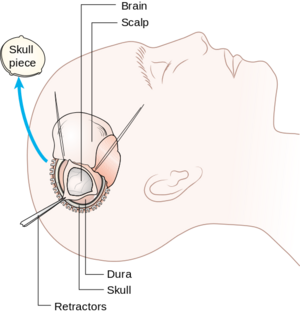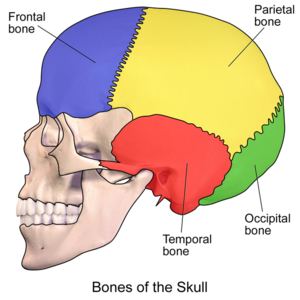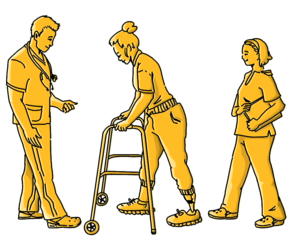Craniotomy: Difference between revisions
No edit summary |
Kim Jackson (talk | contribs) No edit summary |
||
| Line 1: | Line 1: | ||
<div class="editorbox>'''Original Editor '''- [[Chloe Waller]] | <div class="editorbox>'''Original Editor '''- [[Username:Chloe Waller|Chloe Waller]] | ||
'''Top Contributors''' - {{Special:Contributors/{{FULLPAGENAME}}}} | '''Top Contributors''' - {{Special:Contributors/{{FULLPAGENAME}}}} | ||
Revision as of 15:05, 19 September 2022
Top Contributors - Chloe Waller, Kim Jackson, Lucinda hampton, Kirenga Bamurange Liliane, Aminat Abolade and Aya Alhindi
Description[edit | edit source]
A craniotomy is an operation where a part of the skull is removed in order to perform surgery on the brain[1]. If the removed part of bone is not put back, the operation is instead called a craniectomy, and the following surgery where the skull is reconstructed is called a cranioplasty[2].
Indication[edit | edit source]
A craniotomy may be used in the treatment and/ or diagnosis of a number of conditions including[3][2]:
- Brain tumors.
- Brain haematoma.
- Aneurysms.
- Blood clots.
- Increased intracranial pressure (ICP), common after traumatic brain injury.
- Arteriovenous malformations (AVMs).
- Arteriovenous fistulas (AVFs).
- Brain abscesses.
- Dura mater tear.
- Skull fractures.
- Epilepsy.
- To implant stimulator devices for movement disorders.
Types of craniotomy[edit | edit source]
Craniotomies can be classified by the location, size or surgical technique[4]
The location classifications are[5]:
- Orbitozygomatic
The size can range from the smallest, a Burr Hole craniotomy or a keyhole craniotomy, to operations with bone flaps that are multiple centimeters in diameter[4][6].
Another type of craniotomy is an awake craniotomy, where the patient is woken up during the procedure[7].
Post-Op Physiotherapy[edit | edit source]
The level of physiotherapy intervention and rehabilitation post craniotomy varies widely, and is influenced by a number of factors including the actual surgery, the condition which is being treated, the patients' pre-morbid condition and also the general effects of being in hospital[8].
Generally, the goals of physiotherapy post craniotomy are to maintain and/ or increase range of motion and muscle strength, reduce and prevent spasticity and contractures, functional transfer or gait training, and to improve balance and coordination[9].
Within Neurological Intensive Care Units, physiotherapy intervention is both safe and beneficial[10]. The benefits include decreased length of hospital stay, decreased time on ventilation, improved muscle strength and increased independence in activities of daily living[11][12]. It has been found patients undergoing intracranial pressure monitoring received less frequent and intensive physiotherapy[10], despite the evidence standard physiotherapy practice is safe for these patients[13][14]. At present there are no set protocols for physiotherapy post craniotomy[15], and instead care is directed by the physiotherapists' assessment findings.
There can be long term impairments to a patients function and quality of life[16][17], for which they might require ongoing physiotherapy intervention. Rehabilitation programs should be tailored to the individual patient abilities, prognosis and goals[18].
Resources
[edit | edit source]
Brain & Spine Foundation Craniotomy Factsheet
References[edit | edit source]
- ↑ Brain & Spine Foundation. Craniotomy Factsheet. Available from https://www.brainandspine.org.uk/our-publications/our-fact-sheets/craniotomy/ (Accessed 09/06/2022)
- ↑ 2.0 2.1 Fernández-de Thomas RJ, De Jesus O. Craniotomy. Treasure Island (FL): StatPearls Publishing, 2022
- ↑ Johns Hopkins Medicine. Craniotomy. Available from https://www.hopkinsmedicine.org/health/treatment-tests-and-therapies/craniotomy (Accessed 03/06/2022)
- ↑ 4.0 4.1 Neurosurgeons of New Jersey. Understanding the Types and Purpose of Craniotomy. Available from: https://www.neurosurgeonsofnewjersey.com/blog/types-of-craniotomy/ (Accessed 09/06/2022).
- ↑ Rao, D., Le, R. T., Fiester, P., Patel, J., Rahmathulla, G. An Illustrative Review of Common Modern Craniotomies. Journal of clinical imaging science. 2020: 10; 81.
- ↑ Nahed B.V., Oglivy C.S., Anterior Circulation Aneurysms. In: Mohr J.P., Wolf P.A., Grotta J.C., Moskowitz M.A., Mayberg M.R., Kummer R.V. (editors). Stroke (Fifth Edition). W.B. Saunders, 2011. p.1301-1321.
- ↑ Medindia. Craniotomy. Available from: https://www.medindia.net/surgicalprocedures/craniotomy.htm (Accessed 03/06/2022).
- ↑ Taylor B.S., Kellner C.P., Connolly, Jr. E. Postcraniotomy Complication Management. In: Lee K.(editor) The NeuroICU Book (Seconds Edition) [Online]. 2017. Available from: https://neurology.mhmedical.com/content.aspx?bookid=2155§ionid=16396534 (Accessed 13/06/2022)
- ↑ Physio.co.uk. Neurosurgery. Available from: https://www.physio.co.uk/what-we-treat/neurological/neurosurgery/ (Accessed 14/06/2022)
- ↑ 10.0 10.1 Sottile PD, Nordon-Craft A, Malone D, Luby DM, Schenkman M, Moss M. Physical Therapist Treatment of Patients in the Neurological Intensive Care Unit: Description of Practice. Phys Ther. 2015; 95:1 006-1014.
- ↑ Li Z, Peng X, Zhu B, Zhang Y, Xi X. Active mobilization for mechanically ventilated patients: a systematic review. Arch Phys Med Rehabil. 2013; 94: 551–561.
- ↑ Garzon-Serrano J, Ryan C, Waak K, Hirschberg R, Tully S. Bittner E. et al. Early mobilization in critically ill patients: patients' mobilization level depends on health care provider's profession. PM&R. 2011; 3: 307–313.
- ↑ Brimioulle S, Moraine JJ, Norrenberg D, Kahn RJ. Effects of positioning and exercise on intracranial pressure in a neurosurgical intensive care unit. Phys Ther. 1997. Dec; 77: 1682-9
- ↑ Anneli Thelandersson. Early Physiotherapy in the Neurointensive Care Unit Passive Physiotherapy Interventions [Dissertation] Gothenburg: University of Gotherburg. 2016
- ↑ Srivastava A., Sharma N., Srivastav A K., Gehlot A. Functional rehabilitation in intensive care units for post craniotomy patients: study protocol. J. Physiother. Res. 2021: 11: 569-582
- ↑ Pfefferkorn T, Eppinger U, Linn J, Birnbaum T, Herzog J, Straube A. et al. Long-Term Outcome After Suboccipital Decompressive Craniectomy for Malignant Cerebellar Infarction. Stroke. 2009; 40: 3045-3050
- ↑ Mandona L, Bradaïa N, GuettardaI E, Bonana I, Vahedib K, Bousserb MG, et al. Do patients have any special medical or rehabilitation difficulties after a craniectomy for malignant cerebral infarction during their hospitalization in a physical medicine and rehabilitation department? Annals of Physical and Rehabilitation Medicine. 2010; 53: 86-95
- ↑ Parreiras de Menezes KK. Physical Therapy Rehabilitation after Traumatic Brain Injury. J Neurol Neurophysiol. 2016; 6: 311









